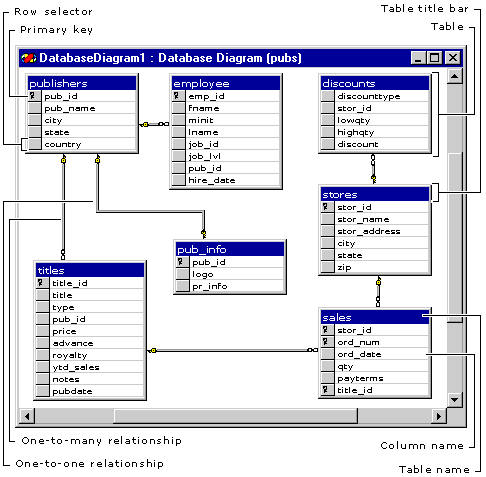
You can easily manage your database graphically through database diagrams. You can use database diagrams to create, edit, manage, or delete database objects (tables, table columns, table relationships, constraints, stored procedures, triggers) while you’re directly connected to the database in which those objects are stored. In the diagram, you can easily see the relationship between the objects in your database. You can also define and edit the properties of the database objects all from within your database diagram.
The tables represented in your diagrams are merely references to tables that reside in the database. An individual database table can exist in more than one database diagram. Thus, a table that appears in many database diagrams actually exists in only one place, the server database itself.

When you modify a table in a database diagram, your modifications are immediately applied to that table in every other diagram that it appears in. Similarly, when you remove a table from a database diagram, it is also removed from the other diagrams that it appears in. Therefore, if you delete a table in a multi-user environment, the table will be removed from the database diagrams of all other users.
When you save a database diagram, all changes you made to the tables in your diagram and their related objects are saved in the server database. You can choose to select only certain tables in your database diagram and save only those tables without affecting the other tables in the diagram.
In most databases, if you perform any of the following actions on a database table, the table will be automatically recreated in your database when you save the table or the database diagram. The table must be recreated in the database in order for your database to accept your changes.
When you save a table on which you’ve performed any of these actions, any triggers, bound defaults, and rules associated with each table are also saved.
| For information about | See |
| Creating tables, changing the table view, adjusting table size, duplicating tables, adding columns to tables | Tables |
| Inserting, moving, deleting columns in database tables and setting properties for those columns | Columns in a Database Table |
| Defining relationships and enforcing referential integrity between tables | Table Relationships |
| Creating indexes to make accessing the information in your tables easier | Indexes |
| Working with constraints to limit the values that can be entered in tables | Constraints |
| Creating, editing, and running stored procedures | Stored Procedures |
| Creating, editing, and running triggers | Triggers |